Novel Research
Click to open the PDF-Version of >Novel Research<
Description of Research Achievements
in enforcement of ultra-low temperatures in biomedical science
reflected in surgical oncology:
discoveries, inventions, exceptional evolution and considerable contribution
to innovatory diagnostics, cure and prevention of malignant diseases
Novel Implemented Research on Ultra-Low Temperatures in Surgical Oncology:
From Fundamental Research to Clinical Implications
University Professor Dr. med. univ. Nikolai N. KORPAN, PhD
International Institute of Cryosurgery, Rudolfinerhaus Clinic, Vienna, Austria
1st Department of General Surgery, National Medical University, Kyiv, Ukraine
www.korpan.at; www.cryosurgery.at; www.isc.cryosurgery.at

In the 1980s at the 1Kiev Medical Institute, Univ.-Prof. Dr. Nikolai N. Korpan began the fundamental theoretical, experimental, technological and clinical studies on ultra-low temperatures in biomedical science and practice in collaboration with engineers and designers.
Since 1995, after the previously official invitation and scholarship of the Federal Ministry of Science and Research, Republic of Austria, Dr. Korpan has steadily continued the pioneering research on ultra-low temperatures in medical science and praxis at the 2International Institute of Cryosurgery in Vienna, founded as private research non-profit institution in 1997, till present.
______________________________________
1 International Institute of Cryosurgery was founded in Vienna in 1997, Vienna, Austria
2 Kiev Medical Institute was renamed in National Medical University in 1995, Kyiv, Ukraine
Korpan’s basic theoretical, experimental and clinical research has provided further scientific and practical foundations on the unexpected role of ultra-low temperatures in different areas of science and medicine concerning the cure and prevention of malignant diseases.
The changes in the world science and medicine with all available scientific data of his own personal theoretical, experimental, clinical, and technological research experience in the period of time from 1982 until the present have served as the objective scientific foundation to define the new terminology and describe the new definition in the field of using low temperatures, especially ultra-low temperatures.
Several phenomena have been observed, discovered and described in the living substances which have become fundamental discoveries of global importance to biomedical science, especially oncology. In this context, the numerous theoretical, experimental, clinical and technological studies, both in vitro and in vivo, which were carried out for tissue devitalisation en bloc in terms of ultra-low temperatures, aimed at the malignancies cure and prevention of malignant cell spread and dissemination locally and systemically. They explained the action of low temperatures on living matter.
The determined phenomena in living substances due to transmission electron microscopy pointed on the cryogenic anti-angiogenesis mechanism, i.e. blocking the tumor vascularization and breaking the oxygen supply to the malignant cells, coupled with the following early and late cryonecrosis and cryoapoptosis.
The cellular freezing and the mechanism of cryogenic damage was investigated by observing ultrastructural changes in response to exposure of ultra-low temperatures in animal experiments. The data show the presence of electron-dense bodies of denatured protein within cryoablated cells. The formation of intracellular protein inclusions following freezing in vivo is a novel observation. The scientific facts of ultrastructural changes in cryoablated hepatic and pancreatic cells in vivo provide a basis for a profound understanding of the mechanism of freezing damage and the pathogenesis of frostbite.
Therefore, the cryogenic vascular circulatory stagnation, cryogenic anti-angiogenesis, aseptic cryonecrosis and aseptic cryoapoptosis are the main crucial pathogenetic mechanisms of living biological tissue damage caused by the ultra-low temperature exposure. The properties of the response of biological living substances after ultra-low temperature exposure have provided important insights into the fundamental pathogenetic mechanisms of formed cryogenic lesion and cryogenic damage in living matter.
In fact, the determined discoveries in voluminous scientific investigations of ultra-low temperatures in vitro and in vivo contributed to deciphering the impact of low temperatures on living biological matter in biological science and medicine, i.e. physiological and pathological (malignant) animal and human tissue
The tumor cryodevitalization (TCD) is defined as one of the main postulates in oncology, especially surgical oncology.
Furthermore, the innovative clinical experience was collected practicing unique and modern minimal organ maintaining cryointerventions in numerous patients with different kinds of malignancies. In fact, the application of ultra-low temperatures was initially carried out by Dr. Korpan for locally advanced pancreas carcinoma with a liquid nitrogen probe as a potential and prospective treatment option worldwide in 1984.
Cryo-assisted resection en bloc, and cryoablation in situ, of primary cancer, particularly primary and secondary breast cancer, was originally introduced by Prof. Dr. Korpan in clinical studies and paves the way for intraoperative cryo-assisted therapeutic strategies for malignant diseases, including primary breast cancer.
The pioneering basic theoretical and experimental research implemented into the clinical experience has substantially contributed to establishing a new discipline in science and medicine, namely Cryosurgical Oncology coupled with modern Cryoscience and Cryomedicine, globally and will doubtlessly contribute to an upsurge in the use of this scientific and medical branch both currently and in the near future.
Therefore, on account of personal results achieved in the field of ultra-low temperatures in biomedical science, namely cryoscience, cryomedicine, cryoimmunology and cryotechnology over the last three decades and based on fundamental and pioneering theoretical, experimental, clinical and technological research, a new standard in biomedical science, namely oncology is explicated in the 21st century.
In conclusion, the personal original review presents a synthesis of previous research on low temperatures, especially ultra-low temperatures and its challenges as well as opportunities in biomedical science used systematic and clearly defined methods to identify, categorize, analyse and report aggregated evidence on basic and clinical cryoscience, cryomedicine, cryosurgery, and cryoimmunology including surgical oncology.
The purpose of the current introduced basic and clinical research using the low temperatures, especially ultra-low temperatures in biomedical science and practice and aimed at the good of mankind is to
1) prevent the local recurrence and distant tissue and organ metastases of the malignancies of different types introduced novel cryodiagnostic & cryosurgical treatment options,
2) enforce the gentle tissue and organ-preserving surgical operations and interventions in patients with precanceroses and malignant diseases, i.e. organ-preserving cryoablation of tumor coupled with intraoperative cryobiopsy as well as prevention or decline any medical [hormonal] replacement therapy,
3) define and elaborate the concept of biocryoimmunology as a new branch of science and medicine as well as study the features and formation of an immune response effect to the ultra-low temperature-altered immunogenic properties organism’s normal and malignant biological structures.
The quintessence of scientific facts due to the fundamental innovative theoretical, experimental, technological and clinical research on ultra-low temperatures in biomedical science as well as its knowledge of materialization in medical practice consist of:
A. FUNDAMENTAL RESEARCH
I. Hypotheses
1.1.
- As any physical process, the effect of the factor of cold on biological living substances and the use of low temperatures in biology and medicine can be both positive and negative. One of the basic objective principles to understand the action of low temperature in vitro and in vivo could be local temperature monitoring or local thermo-monitoring (LTM).
- Furthermore, LTM could be used in a study of a dynamic temperature field as well as for the optimization of regimes of cryogenic exposure in several fields of biomedical science.
- The process of biological living structure damage consists of a series of reactions in response to freeze-thawing. However, all pathogenetic mechanisms are not known currently and further physical and biological investigations, especially experimental research, could be continued, to understand the mechanisms of damage and cryogenic lesion after freeze-thawing, especially during and after cryosurgical procedures in biomedical science and medical practice, i.e. surgical oncology, cryoscience, cryomedicine, cryosurgery.
- Living biological objects resonate with a special response to the local effect of low temperatures, especially ultra-low ones. Their response is an involuntary process in living nature, consisting of a whole cascade of biological phase changes and special patterns that continuously change each other and transform from one form to another. With the local effect of low temperatures, especially ultra-low temperatures, on living biological structures, a specific mechanism complex of the transformation of vital physiological and physic-biochemical processes into avital (non-vital) and irreversible mapping (condition) of a local evolution of living matter into non-living is launched in a flash.
- This objective activity of living matter transiting to non-living under the direct influence of low temperatures, especially ultra-low temperatures, is one of the postulates in the global specialty of novel application of low temperatures in biomedical science and practice. We confirmed this rare occurrence (phenomenon) as a postulate initially in own experimental models, then in vitro and in vivo.
- First, in 2001, 2007 and 2009 the special dendritic cells called cryocell detritus (CCD) were discovered and observed in vivo by Korpan NN (Korpan NN. Ed. Atlas of Cryosurgery. Springer, New York, Vienna, Sydney, Tokyo, Munich (2001). 1-525; Korpan NN. Ed. Basics of Cryosurgery. Springer, New York, Vienna, Sydney, Tokyo, Munich (2001). 1-325; Korpan, N. N. Cryosurgery: ultrastructural changes in pancreas tissue after low temperature exposure. Technol Cancer Res Treat (2007) 6: 59-67; Korpan, N. N. Cryosurgery: Early ultrastructural changes in liver tissue in vivo. J Surg Res (2009) 153(1): 54-65) using the cryosurgical approach in terms of cryoprobe placed on the animal pancreas parenchyma and liver tissue at the temperature range of -80 °C and -180 °C. The electron microscopic study of the animal’s pancreas and liver shown cell detritus and fibrin fibers twenty-four hours after the cryosurgical intervention at -180 °C, i.a. a single freeze-thaw cycle. In this context, the observed cryocell detritus-dendritic cells - forming after the exposure to ultra-low tempertures on living biological tissue in vivo could be an indication of one of the important mechanisms for the cryoimmunological response of living structures to the impact of ultra-low temperatures.
1.2.
- The coldest tissue temperature is the prime factor in cell death. The changes in normal and pathological living nature, i.e. cell lines, tissue structure, fluid systems, could be dependent on different low temperature exposures, especially deep low temperatures. Using superficial low temperatures in the range of -20 °C to -80 °C can lead to incomplete pathological lesion destruction, especially in oncology with a following tumor local recurrence and distant multiple metastases. An insufficient or inappropriate freezing can’t completely destroy the target pathological tissue, which may lead to malignancy regain growth and, thus, failure of therapeutic options using low temperatures in medicine.
- Therefore, a novel concept of the unique high-tech cryogenic technology, especially cryosurgical equipment, could be developed on the basis of new knowledge and know-how, which can be used universally in the different fields of biomedical science, especially cryoscience and cryomedicine.
1.3.
- The term “Biocryoimmunology: Autologous and Allogeneic Cryoimmunology – A New Discipline in Bioscience and Medicine” and its definition were first introduced by Korpan NN (Korpan, NN. Cancer Cryoimmunology: Theory, Experimental and Clinical Experience since 1982. Fuda International Symposium on Cancer, 19-20 December 2012, Guangzhou, China. Congress Book (2012) 9; Korpan, NN. Cancer Cryoimmunology: 30-year-long Own Experience. 17th World Congress of the International Society of Cryosurgery, 11-14 December 2013, Bali, Indonesia. Congress Abstract Book (2013) 27; Korpan NN. Biocryoimmunology: Impact of Cytology. Cryobiology (2020).
- The field of study for biocryoimmunology (BCI) suggests the investigation of the peculiarities of changes in the immune system's biological substrates' structural and functional characteristics after cryopreservation, as well as the study of the formation of new immunogenic biological substances of an autologous nature under the influence of ultra-low temperatures, achieved by active rapid freezing, and simple passive slow warming in vivo and in vitro.
- BioCryoImmunology in Living Nature: BioImmunCryoSubstances (BICS): Genesis detection probably of new biological substances originating or derived from physiological and pathological sources by individuals as a Biological Activator Substance (BAS)namely human BioImmunCryoSubstances (BICSh),for example CryoCellParticles (CCP) in form of human BioImmunCryoAntigens (BICAg) with following human BioImmunCryoAntibodies (BICAb)which provoke a cascade ofcellular and humoral Immunological Cryogenic Response (ICR) by use of ultra-low temperatures through intra- and extra-corporal active rapid freezing and passive tardy thawing.


II. Theories
The basic theoretical aspects were developed, and novel concept of thermal cascade phases is illustrating below.
The response of living biological substances and tissues to low temperatures, including ultra-low temperatures is acquired in
Theoretical model A.
2.1.

2.2. Thermal synthesis of tissue response on low temperature: Main characteristics of temperature zones resulting from low temperature exposure. This is acquired in Theoretical model B.

2.3. New Terminologies and Definitions which were introduced into modern biomedical science: cryoscience, cryomedicine, cryogenic phenomenon, cryogenic denaturation, cryogenic anti-angiogenesis, cryogenic apoptosis, cryogenic necrosis, nano-cryoscience, nano-cryoablation, nano-cryodevice, cryogenic devitalization, cryogenic tumor devitalization, biocryoimmunology.

III. Experimental Studies
A) Physical Investigations
The fundamental studies in vitro and in vivo were carried out as follows:
- New experimental model was developed for the investigation of the dynamic temperature field of the frozen zone and the definition of the four phases for the effect of low temperatures on living tissue
- Investigations of the effect of freeze-thawing processes using low temperatures of varying intensity from -40 °C to -180 °C by means of disc-shaped cryoprobes with diameters of 5 to 50 mm respectively as well as cryo-needles with a diameter of 10 mm in vitro

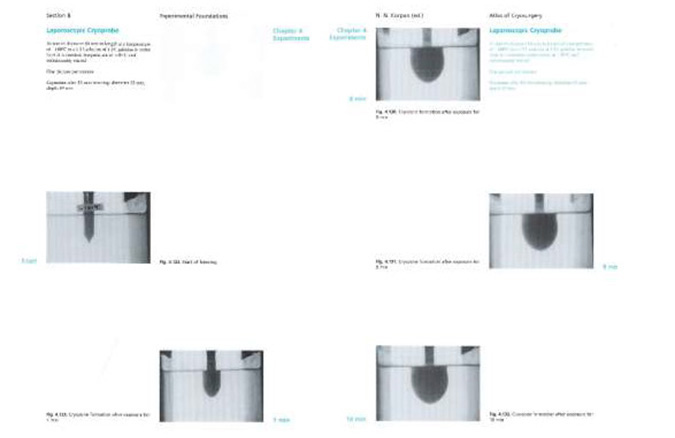
B) Biological Investigations
The several experimental studies of the biological living substances in animal experiments provide a platform to profoundly understand the mechanisms of damage and the pathogenesis of frostbite during low temperature exposure. The cryogenic response of parenchymal tissue, i.e. ultrastructural cellular changes in parenchymal organs: liver and pancreas tissue, were investigated. This gives rise to a new concept concerning the technical requirements of cryogenic equipment use in modern biomedical science, especially in surgical oncology and biogenic immunology.

The scientific implication of longstanding research clearly is to define that early and late cryosurgical vascular changes and circulatory stagnation together with the following cryo-aponecrosis and cryo-apoptosis as well as cryosurgical anti-angiogenesis and blocked the tumor vascularisation with immediately stopping oxygen supply to the tumor cells are the main important mechanisms of living tissue damage (liver, pancreas) as a response to ultra-low temperatures via freezing-thawing process. This initiated an irreversible damage tissue process and finally leads to complete destroying of malignant tumor mass. These are the main mechanisms of biological living tissue injury following the ultra-low temperature exposure. Especially these mechanisms are well elucidated and illustrated at the deep temperature of -180 °C.

The findings of the investigations allow for clearly defining the clinical implication for the main technical requirements to cryosurgical devices. The main technical parameter stipulating for the effective tissue cryo-devitalization (cryoablation) is the provision of a high freezing rate of the biological tissue followed by further deliberate thawing.

The unique phenomena have been observed and discovered in living matter and become fundamental discoveries of significant importance in biomedical science and practice. Essential steps have been taken in the evolution of modern cryoscience and cryomedicine.

Discoveries
3.7.1. The phenomenon “Cryogenic Protein Denaturation”: Here was discovered a natural phenomenon and the early and late ultrastructural cellular outcomes in hepatocytes after ultra-low temperature exposure in vivo were shown using transmission electron microscopy. Immediately and one hour after freeze-thawing, hepatocytes display a disrupted plasma membrane, and mitochondria are observed with electron-translucent matrix and disrupted membranes. Electron-dense inclusions of denatured protein are also notably present. Immediately and 24 hours after the cryogenic procedure, full lysis of plasma membranes and the presence of picnotic nuclei are observed. Mitochondria with lysed matrix and disrupted external and internal membranes are once again observed, as are the denatured protein bodies. He regards this as most significant and novel observation of intracellular cryodenatured protein inclusions. Such freezing-induced denatured protein bodies have not previously been reported in vivo.
The formation of intracellular protein inclusions following freezing in vivo is a ground-breaking discovery. This discovery observation would be of great general interest and provides the scope for interdisciplinary research in the fields of space science, biophysics, biochemistry, biology and engineering as well as in cryoscience and cryomedicine, cryoengineering and space medicine. This is next of the main mechanisms of deciphering ultra-low temperature impact on living matter in nature.
However, in presented research, the nano-structures of the living substances were fragmented and denaturated into smaller nano-particles following ultra-low temperature exposure, leading to the ultra-low temperature interitus of the living matter on a nanometric scale and, finally, to local irreversible and avital lethal cell cryogenic explosion, namely cell cryo-non-vita.
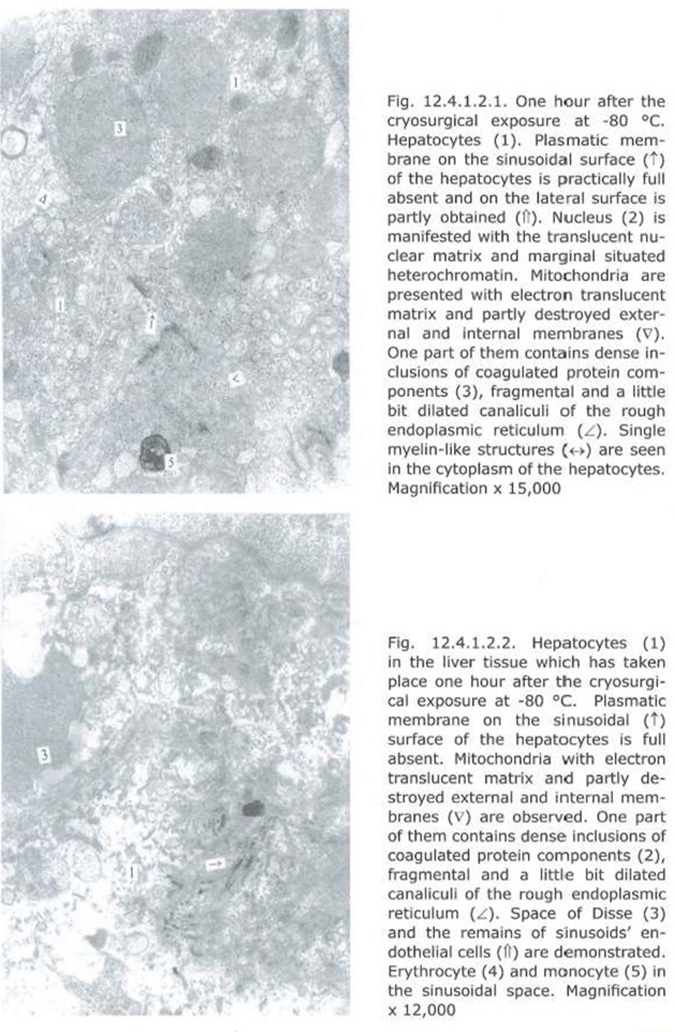
3.7.2. The Phenomenon "Lunar Eclipse": The early and late ultrastructural cellular changes, which were presented by the exposure of low temperatures at -80 °C and -180 °C in vitro, refer to the fundamental pathogenetic mechanisms in living matter. The properties of the living biological structures response after ultra-low temperature exposure provide important insights into the mechanisms of damage and the cryogenic lesion after the freeze-thawing process in its different phases in the field of biomedical science, i.e. cryoscience, cryomedicine and cryosurgery.
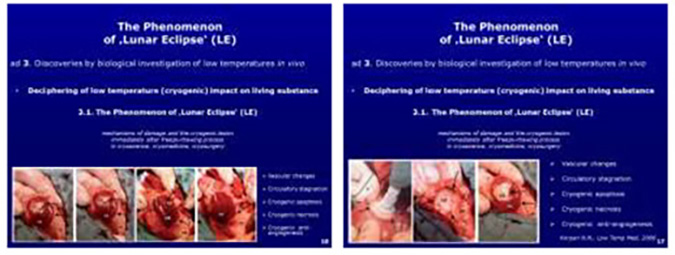
The Phenomenon “Anthill Provocation Stimulus-Phenomenon” (APS-Phenomenon): There are natural phenomena that can be characterized by their analogy with physiological and pathological processes in the human organism. An anthill that constitutes an autonomous balanced subsystem can be transformed immediately into a “dynamic chaos” by exogenous interventions. Small impacts can already turn a snowfield into an avalanche through exponential dynamics. These images are using in order to demonstrate a dead end of surgical oncology, resulting very frequently in fatal consequences and human tragedies. An external intervention (“operation”) in an anthill will cause a defect which opens the previous “balanced state” of the entire closed ant autonomy; locally the “gate” being created constitutes an anomaly to the system. This results in the destabilization of the entire system. A state of chaos being created – in this case only temporarily – will give impulses for activities for the ants. The confused ants will accelerate their motion dynamics not only within the present system space but expand it outwards as well.

The Phenomenon „Cryosurgical Avascular Tumor“ (CAT-Phenomenon): The research carried out shows that when the cryosurgical freeze-thaw cycle is finished and the cryozones with the ice crater in the middle, and the ice margin with the line of demarcation are thawed, the healthy liver parenchyma has taken on the colour of the dye. This occurs after cryosurgical application on the multiple liver metastases, but the cryoextirpated liver metastases have not been dyed, the cryoextirpated liver metastases are not dyed as well. Only the healthy hepatic parenchyma is sensitive to colour, but large liver metastases with the post-cryosurgical zone are not sensitive to colour. The absence of dye indicates a post-cryosurgical avascular tumor area.
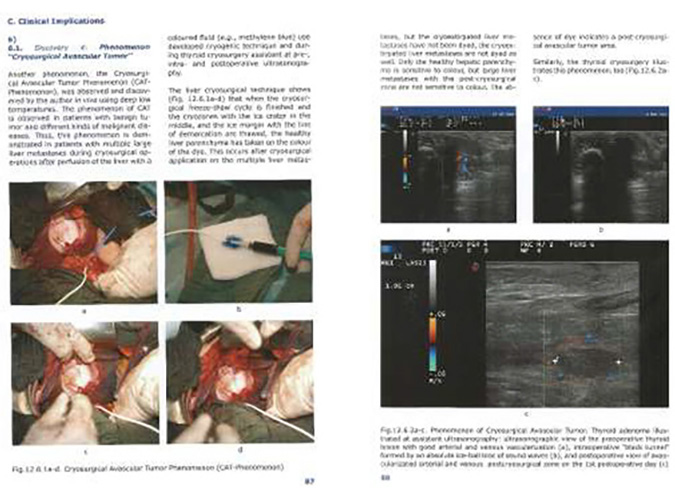
The bacteriological findings were negative in all experimental studies (P<0.001). The data generated by studies shown that the early and late ultrastructural pancreatic and hepatic cell changes seen in the post-cryogenic zone after freeze-thawing immediately, one hour and twenty-four hours indicate the non-vital continuation of the whole post-cryosurgical destructive process, i.e. the phase of irreversible and aseptic cryocytonecrosis with a subsequent phase of irreversible aseptic cryoapoptosis. In all groups studied the bacteriological results have not yielded any growth of microorganisms (P<0.001).
The results of studies have shown that the early and late pancreatic and liver cell changes in the post-cryogenic zone being observed in the first twenty-four hours after the freeze-thawing cycles are the beginning phase in the whole post-cryogenic process. They lead to the next phase of aseptic cryoaponecrosis and then to aseptic cryoapoptosis which, in many weeks, will clinically finish by the formation of an avital post-cryosurgical crust and, finally, a post-cryogenic (post-cryosurgical) scar.

3.10. For the first time, it has been proved that cold surgery is the first surgical technique to use anti-angiogenesis, especially in the treatment of malignant diseases.
IV. PIONEERING CLINICAL EXPERIENCE
Patient population. The clinical experience was collected due to the development and performance of numerous innovative modern curative and palliative minimal-interventional and organ-preserving (organ-maintaining) cryosurgical operations in patients with several primary and secondary kinds of malignancies: skin cancer and metastases, malignant melanoma, breast cancer and local recurrence, multiple large hepatic metastases, head pancreas adenocarcinoma, stomach and colon adenocarcinoma, rectal and anal cancer, thyroid tumor, tissue malignancy tumor, lymph node metastases.
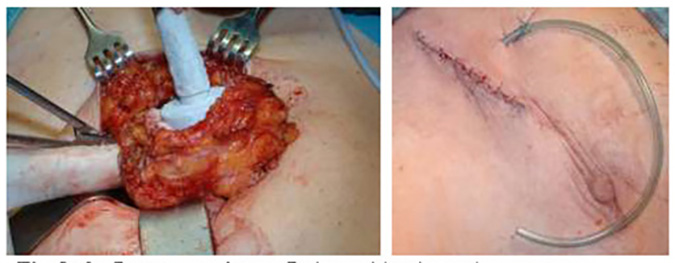
Fig. 1a,b. Patient population. Patient with primary breast cancer. Novel cryosurgical approach aimed at prevention of local recurrence and distant tissue and organ metastases. Inpatient stay 3 days. No postoperative complications.

Figures 1a-4b. Patient population. Patient with primary colon adenocarcinoma underwent novel cryosurgery without blood transfusion and shorter hospital stay of 7 days. aimed at prevention of local recurrence and distant tissue and organ metastases. No postoperative complications.
This is summarized as a long-term follow-up clinical experience with cryosurgery for treatment of liver metastases. The data of this 10-year prospective, randomized clinical trial suggest that hepatic cryosurgery is effective in the treatment of resectable and non-resectable liver metastases published in Annals of Surgery, USA, 1997. Please note: this journal is listed on the 1st place under 134 renowned international scientific journals, among those Germany leading journal “Chirurg” is only indexed on 26th place.
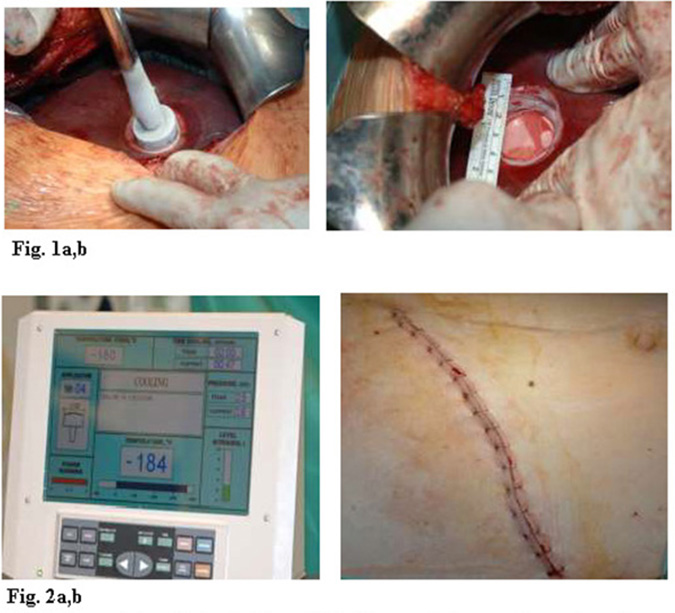
Patient population. Patient with multiple liver metastases underwent modern cryosurgery without blood transfusion and shorter hospital stay of 5 days – no postoperative complications (Figures 1a-2b)
Original use of ultra-low temperatures was introduced not only in palliative minimal-interventional oncology but, for the first time, in the anti-tumour treatment concept by patients with primary malignancies, especially breast cancer, malignant melanoma, stomach and colon adenocarcinoma, rectal and anal malignancies aimed to the cure and prevention of local and systemic malignant cell spread and dissemination referring tumor local recurrence and multiple distant metastases.
Likewise, the discoveries described above have changed current preoperative invasive malignant tumor diagnostics. Invasive cryo-diagnostics were described and introduced in the medical practice.
Hence, the challenge in current invasive tumor diagnostics via invasive cryo-diagnostics of malignant diseases is a postulate in state of temporary primary tumor mass immobilization aimed at the prevention of local and systemic malignant cell dissemination and, finally, prophylaxis of local tumor recurrence and multiple distant metastases.
V. INNOVATIVE DEVELOPMENT of CRYOGENIC TECHNOLOGY
The new universal cryogenic techniques for malignant curative and palliative treatment in the field of dermatological abdominal, breast and thyroid cryosurgery, cryosurgery for soft tissue malignant tumors and lymph nodes metastases, etc. have been discovered and developed. The new concepts, discoveries, inventions and development of the unique high-tech and innovative cryogenic technology: instruments and devices are introduced in 46 National, European and International Patents (USA, Japan).

The original engineering developments have opened up the novel era to translation of the fundamental research to the clinical implications in the area of surgical oncology worldwide.

VI. BENEFIT for HUMAN CIVILIZATION

Fig. 6a. Patient population. Short medical history. The patient said in State ORF TV-Interview, Modern Times, 01/2003, Republic of Austria: “Well, at first, it was a shock for me if the doctors announced about my malignant disease namely malignant melanoma. I thought that it cannot be true that I have so many different spots. Further, the doctors in Germany and Austria said me that I will have to face several surgeries at what below-knee amputation. That means - in hospital! And after the surgical operation the immunotherapy, chemotherapy … and then I thought: there has to be another treatment possibility… Professor Korpan told me – after the findings had been made – that I am healed. And I believed him. I had great confidence; and I have it as well. Well, my head told me as well: it is gone. And I am no longer thinking of it. Well, I am really happy about the excellent treatment option namely modern cryosurgery by Prof. Dr. Korpan”.
Surgical operation: Organ-maintaining cryoablation of malignant melanoma on the left lower leg combined with intraoperative cryo-biopsy instead lower leg amputation left with followed chemo-, immune- and radiotherapy. Histology: Malignant nodular melanoma. Follow up: 20 years. Life quality is normal. All motion functions are available. The patient is free of complaints, disease-free and does not take any special medical therapy. Bland and soft scar. References: 1) Korpan NN. Cryoscience and Cryomedicine. From Fundamental Research to Clinical Implications in Scientific Facts. University Facultas Publisher, Vienna, Austria, 2009; pp. 1-462. 2) Korpan NN. Cryoscience and Cryomedicine. Lecture at the Karolinska Institutet, Stockholm, Sweden, 25 March 2009. University Facultas Publisher, Vienna, Austria, 2009; pp. 1-217.

Lastly: At present, follow-up 20 years. Patient is disease-free, February 17th, 2019. Neither chemotherapy, immuntherapy nor radiotherapy (Fig 6a-d).
The fundamental and novel research on ultra-low temperatures in biomedical science and clinical practice aimed at prevention of local recurrence and distant metastases as well as change paradigms in medicine, especially surgical oncology against malignant diseases has currently led to benefits for human civilization in science and medicine globally.
In this context, the following basic principles and significant postulates were introduced using modern low temperatures in biomedical science and practical medicine:
- deciphering of pathogenic mechanisms of biological living matter damage, following the low temperature exposure
- prevention of recurrence of local malignancies and systemic distant multiple metastases per completely TumorCryoDevitalisation (TCD) blocking malignant cell spread into the surrounding healthy tissue, blood and lymph vessels as well as dissemination into the regional and distant organs during the convential surgical procedures (operation)
- the implementation in practice of the research results has raised the level of modern medicine in human civilization
- challenge in current invasive malignant tumor diagnostics based on the development of a new standard – invasive cryo-diagnostics
- amplification of organ maintaining and gentle invasive interventions on the human organism
- definition and introduction of new standards in prevention, diagnostics and treatment of malignant diseases
- contribution to establishing a new discipline in biomedical science, namely cryoscience and cryomedicine
- contribution to developing an innovative era for modern cryo-technology and hi-tech cryo-equipment
Numerous workshops and seminars on modern biomedical science, specifically cryoscience. cryomedicine and surgical oncology including cryo-oncology have continuously been carried out at several medical, scientific and educational institutions globally: Austria, USA, Germany, Sweden, Australia, Italy, Hungary, Poland, Ukraine, Russia, Jordan, Iraq, Arabic United Emirates, Vietnam, Moldova, China, Romania, Indonesia, Japan, Malaysia, Philippines, etc.

Patient population. Next patient C.I., 72-year-old. Diagnosis: Status post cryo-assisted colon resection aimed at prevention of local recurrence and distant metastases due to malignant colon carcinoma without systemic chemotherapy, survival time 10 years. Patient is disease free (Fig. 1).

Fig. 1a,b. Patient population. Patient G.O., 45-year-old, undergone cryo-assisted breast resection en bloc in consequence of primary breast cancer aimed at prevention of local recurrence and distant metastases. Survival rate: 15 years. Patient is disease free currently.
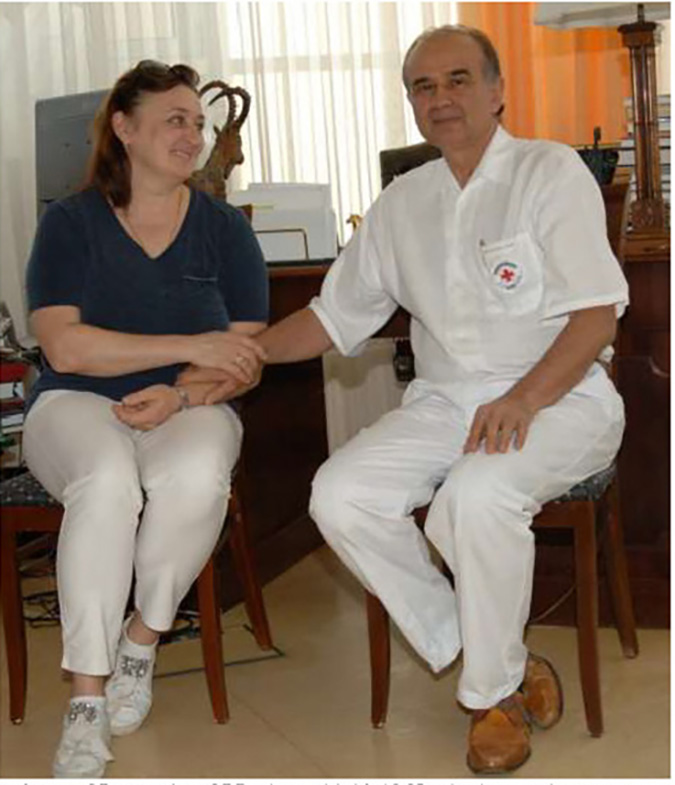
Patient population. Next patient N.L., born 11.10.1968 who has undergone cryo-assisted breast resection en bloc due to primary breast cancer right aimed at prevention of local recurrence and distant metastases on 25.03.2013. Survival rate: 7 years. Currently patient is disease free (Fig. 1).

Patient population. Next patient S.T., born 01.02.1955. Operation: Cryo-assisted thyroid resection en bloc aimed at prevention of local recurrence and distant metastases on 16.01.2008. Diagnosis: Multifocal sclerosed papillary thyroid carcinoma, pT4b, No, (0/3) MX. No postoperative complications. Follow-up 11 years. Patient is disease free at present (Fig. 1a-c).

Fig. 1a,b. Patient population. Patient B.O., born 28.03.1961. Diagnosis: Stomach ulcerated seal ring cell carcinoma, lymph nodes metastases, stage pT2b, N1, (MIC), MX, R-0. Operation: Cryo-assisted stomach resection en bloc coupled with lymphadenectomy aimed at prevention of local recurrence and distant metastases. No postoperative complications. Survival time 11 years.

Patient population. Next patient C.G., born 14.04.1938. Diagnosis: Invasive high differentiated rectum adenocarcinoma G1, stage pT3, N0, LO, VO, RO. Operation: Cryo-assisted rectum resection en bloc aimed at prevention of local recurrence and distant metastases in 2010. No postoperative complications. Survival time 10 years, at present patient is disease free (Figures 1a-d).

Fig. 1a-c. Next patient E.M, 83-years-old. Diagnosis: Oral erythroplakia. Operation: Cryoablation en bloc in 2001 aimed at prevention of local recurrence and distant metastases without complications. No systemic chemo- and local radiotherapy. Survival time 19 years. Patient is disease free at present.

Fig. 1a-5d. Patient population. Patient E.V., 68-years-old (Figures 1a-5d). Diagnosis: Primary recto-sigmoidal adenocarcinoma. Cryo-assisted colon resection en bloc with reference to intraoperative tumor cryo-devitalisation aimed at prevention of local recurrence and distant metastases coupled with artificial anus for the time of 3 months. Surgical operation: 03/2015. No blood transfusion, no postoperative complications. No systemic chemo- and local radiotherapy. Survival time 5 years. At present, patient is disease free.

Fig. 1a-5d. Patient population. Next patient M.S., born 02.01.1948. Diagnosis: Stomach adenocarcinoma. International Institute of Cryosurgery, Rudolfinerhaus Private Clinic, in the operating theatre, Vienna, Austria, 18.04.2019: Cryo-assisted stomach resection en bloc by Billroth II coupled with lymphadenectomy and omentectomy aimed at prevention of local recurrence and distant metastases. No blood transfusion. No postoperative complications. No systemic chemo- and local radiotherapy. Survival time 1 year. Patient is disease free.

Fig. 1a-5c. Patient population. Young Patient R.P., born 35-year-old. Diagnosis: Nodular gointer right 17x14x19mm with hyperperfused hem and finding progression. Surgical operation: Organ-preserving cryoablation of nodular gointer on the right thyroid lobar combined with intraoperative cryo-biopsy instead hemithyroidectomy right. Histology: Hyperplastic thyroid adenoma. Follow up: 1 year. All thyroid function parameters normal and thyroid tissue existing in both thyroid lobes 100% anatomically and complete homogenously. The patient is free of complaints, disease-free and does not take any medical hormonal replacement therapy. Bland scar.
Histological diagnosis verification: Intraoperative CryoBiopsy

Fig. 1a-f. Patient population. Next patient G.K., born 18.01.1955. Diagnosis: Multiple large liver malignant metastases. Cryosurgical operation (29.01.2017): Open cryoablation of liver metastases en bloc with intraoperative cryobiopsy for histological diagnosis verification in order to avoid preoperative diagnostics intervention as well as prevention of local recurrence and distant metastases. No bleeding. No postoperative complications. Conservative therapy is continued. Survival time over 3 years.

Fig. 1a-m. Patient population. Next patient O.T., 61-year-old. Diagnosis: Primary malignant melanoma, digitorum I right. Cryosurgical operation (16.02.2017): Cryoablation of melanoma in local Oberst-anaesthesia en bloc with intraoperative cryobiopsy for histological diagnosis in order to avoid preoperative diagnostics intervention, prevention of postoperative local recurrence and distant metastases as well as organ-preserving surgical approach. No bleeding. No postoperative complications. No chemo-, radio- and immunotherapy postoperatively. Thumb function completely. Survival time over 3 years. Patient is disease free.
For further Information visit:
1) ISC (Internatinal Society of Cryosurgery)
2) WAM (World-Anticancer-Movement)
